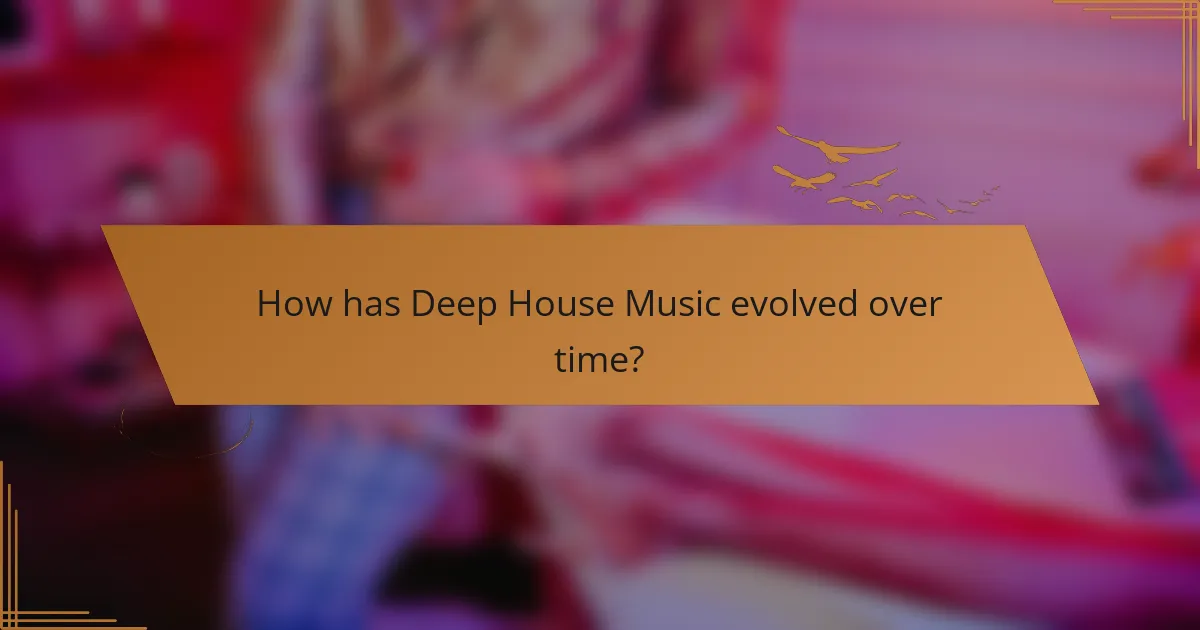Deep house music is a subgenre of house music that originated in the 1980s, characterized by its complex melodies, soulful vocals, and slower tempo ranging from 120 to 125 beats per minute. Influenced by jazz, funk, and soul, deep house has evolved over the decades, incorporating various musical styles and digital production techniques. Key elements of successful deep house tracks include steady beats, deep basslines, jazzy chord progressions, and atmospheric pads. The genre has gained mainstream popularity, with notable artists like Disclosure and Duke Dumont contributing to its widespread appeal in clubs and festivals worldwide. This article explores the evolution of deep house music, detailing its defining characteristics and the musical elements that contribute to its enduring success.

What is Deep House Music?
Deep house music is a subgenre of house music characterized by its complex melodies and soulful vocals. It emerged in the 1980s, influenced by jazz, funk, and soul music. The genre typically features a slower tempo, often between 120 to 125 beats per minute. Deep house is known for its atmospheric sounds and deep basslines, creating a laid-back vibe. Notable artists include Larry Heard and Frankie Knuckles, who helped shape its distinctive sound. The genre has evolved, incorporating elements from various musical styles over the years. Today, deep house remains popular in clubs and music festivals worldwide, showcasing its lasting appeal.
How did Deep House Music originate?
Deep House Music originated in the 1980s in Chicago. It evolved from the combination of elements from house music, jazz, and soul. Pioneers like Larry Heard and Frankie Knuckles were instrumental in its development. The genre is characterized by its use of complex melodies and deep basslines. Vocals in deep house often feature a soulful quality. The genre gained popularity in clubs and underground scenes. By the 1990s, it spread to Europe, influencing the global music landscape. Today, deep house remains a prominent genre within electronic dance music.
What influences shaped the early sound of Deep House?
The early sound of Deep House was shaped by a fusion of various musical influences. Key genres included jazz, soul, and funk. The incorporation of these styles added rich melodies and complex harmonies. Chicago house music also played a significant role in its development. Pioneers like Frankie Knuckles and Larry Heard were instrumental in this evolution. Their use of synthesizers and drum machines created a distinctive sound. Additionally, the influence of disco brought rhythmic elements and a danceable quality. These combined factors established the foundational characteristics of Deep House music.
Who were the key pioneers in the development of Deep House?
Larry Heard, also known as Mr. Fingers, is a key pioneer in the development of Deep House. He produced influential tracks like “Can You Feel It” in the mid-1980s. His work emphasized soulful melodies and deep bass lines. Another significant figure is Frankie Knuckles, often referred to as the “Godfather of House.” He played a crucial role in popularizing the genre in Chicago. His remixes and productions helped shape the sound of Deep House. Additionally, Kerri Chandler is recognized for his deep and atmospheric productions. His tracks often feature rich chord progressions and intricate rhythms. These artists laid the foundation for Deep House, influencing countless musicians and producers. Their contributions continue to resonate in modern electronic music.
What are the defining characteristics of Deep House Music?
Deep House Music is characterized by its smooth, soulful sound and deep basslines. It typically features a tempo ranging from 120 to 125 beats per minute. The genre often incorporates jazzy chords and atmospheric synths. Vocals in Deep House are usually soft and melodic. The use of samples from funk and soul music is common. Additionally, it emphasizes a laid-back vibe suitable for relaxation and dancing. Deep House emerged in the 1980s, blending elements of house, jazz, and funk. This historical context supports its unique sound and style.
How does Deep House differ from other house music genres?
Deep House differs from other house music genres through its unique sound and production techniques. It typically features slower tempos, usually between 120 to 125 BPM. Deep House incorporates complex melodies and harmonies, often with jazz and soul influences. Its use of atmospheric pads and deep basslines creates a more immersive listening experience. Unlike other house genres, Deep House often emphasizes vocal samples and emotive lyrics. The genre emerged in the 1980s, influenced by Chicago house and Detroit techno. Tracks often have a smoother, more laid-back vibe compared to the more upbeat styles like Tech House or Progressive House.
What are the common elements in Deep House tracks?
Common elements in Deep House tracks include smooth basslines, soulful vocals, and atmospheric pads. The basslines are often deep and groovy, contributing to the genre’s laid-back feel. Vocals in Deep House frequently feature emotive and melodic qualities, enhancing the track’s emotional depth. Atmospheric pads create a rich soundscape, adding layers of texture. Additionally, Deep House often incorporates elements of jazz, funk, and soul, which influence its rhythmic structure. The tempo typically ranges from 120 to 125 BPM, providing a steady groove. These characteristics collectively define the essence of Deep House music.

How has Deep House Music evolved over time?
Deep House Music has evolved significantly since its inception in the 1980s. Initially, it emerged from Chicago house music, characterized by its slower tempo and complex melodies. In the 1990s, the genre incorporated elements from jazz, soul, and funk, which added depth and richness to its sound. The introduction of digital production techniques in the 2000s allowed for greater experimentation with soundscapes and textures.
As technology advanced, artists began to blend deep house with other genres, such as techno and ambient music. This fusion led to a more diverse range of tracks and styles. In the 2010s, deep house gained mainstream popularity, with artists like Disclosure and Duke Dumont bringing it to wider audiences. The rise of streaming platforms further contributed to its evolution, allowing for global access to deep house music.
Today, deep house continues to evolve, incorporating influences from various musical styles while maintaining its foundational elements. The genre remains a staple in clubs and festivals, showcasing its lasting impact on the electronic music scene.
What major milestones mark the evolution of Deep House?
Deep House evolved through several major milestones. The genre originated in the 1980s, influenced by Chicago house music. In the early 1990s, artists like Larry Heard and Frankie Knuckles popularized the sound. The introduction of soulful vocals and jazz elements defined its early style. By the mid-1990s, Deep House gained traction in Europe, especially in the UK and Germany. The 2000s saw a resurgence with artists like Miguel Migs and Kaskade bringing it to mainstream audiences. In the 2010s, the genre incorporated elements from tech house and minimal, expanding its reach. Today, Deep House remains a staple in clubs worldwide, showcasing its lasting impact on electronic music.
How did technology influence the production of Deep House music?
Technology significantly influenced the production of Deep House music by introducing advanced tools and techniques. Digital audio workstations (DAWs) like Ableton Live and Logic Pro enabled producers to create, edit, and mix tracks more efficiently. Synthesizers and samplers expanded the sonic palette, allowing for richer textures and innovative sound design. MIDI technology facilitated precise control over musical elements, enhancing creativity in composition. The rise of virtual instruments made high-quality sounds accessible to a broader range of artists. Additionally, online distribution platforms revolutionized how music was shared and consumed, increasing the genre’s reach. These technological advancements shaped the evolution of Deep House, making it more diverse and accessible to producers and listeners alike.
What role did cultural shifts play in the evolution of Deep House?
Cultural shifts significantly influenced the evolution of Deep House. The genre emerged in the 1980s, reflecting the social changes of that era. It incorporated elements from disco, soul, and jazz, which were prevalent in urban nightlife. The rise of electronic music technology allowed for innovative sound experimentation. Cultural movements, such as the [censured] rights movement, also played a crucial role in shaping Deep House’s inclusive atmosphere. As communities sought spaces for expression, Deep House became a soundtrack for liberation and identity. The genre’s themes often mirrored the struggles and joys of these cultural shifts, making it deeply resonant with its audience. Ultimately, Deep House evolved as a reflection of the changing cultural landscape, adapting to new influences and societal contexts.
What are the current trends in Deep House Music?
Current trends in deep house music include the integration of live instrumentation and organic sounds. Artists are increasingly incorporating elements from jazz, funk, and soul. This trend enhances the emotional depth of tracks. Additionally, there is a rise in collaborations between deep house producers and vocalists from various genres. This fusion creates a diverse sound palette. The use of vintage synthesizers and analog gear is also gaining popularity. This choice adds warmth and texture to the music. Furthermore, the focus on immersive experiences in live performances is becoming more prevalent. DJs are curating atmospheres that engage audiences on multiple sensory levels. These trends reflect a broader evolution in the deep house genre, emphasizing creativity and innovation.
How are modern artists redefining Deep House sound and style?
Modern artists are redefining Deep House sound and style by incorporating diverse musical influences. They blend elements from genres like techno, jazz, and ambient music. This fusion creates a richer and more textured sound. Artists experiment with vocal samples and live instrumentation. They also utilize advanced production techniques that enhance the auditory experience. The integration of technology allows for innovative sound design. Many modern tracks feature deeper basslines and atmospheric pads. This evolution reflects a broader cultural shift in electronic music.
What sub-genres have emerged from Deep House in recent years?
Sub-genres that have emerged from Deep House in recent years include Melodic House, Afro House, and Chill House. Melodic House combines deep house elements with melodic and harmonic progressions. Afro House incorporates African rhythms and instruments, creating a unique fusion. Chill House emphasizes laid-back vibes, often featuring softer beats and ambient sounds. These sub-genres reflect the evolving landscape of deep house music. The rise of streaming platforms has facilitated the discovery of these styles. Additionally, artists are increasingly blending genres, leading to innovative sounds within the deep house realm.

What are the key elements of successful Deep House tracks?
Successful Deep House tracks typically feature a combination of specific musical elements. These include a steady four-on-the-floor beat, which creates a consistent rhythmic foundation. Deep basslines are essential, providing warmth and depth to the track. Chord progressions often utilize jazzy or soulful influences, adding emotional richness.
Vocal samples are frequently incorporated, enhancing the track’s atmosphere and relatability. Atmospheric pads create an immersive soundscape, contributing to the overall vibe. The use of syncopated hi-hats adds groove and movement, making the track danceable. Finally, a polished production quality is crucial, ensuring clarity and balance across all elements.
These elements collectively define the essence of successful Deep House tracks, making them appealing to listeners and dancers alike.
What production techniques are commonly used in Deep House?
Deep House production techniques commonly include the use of smooth, jazzy chords and complex basslines. Producers often incorporate soft, soulful vocals to enhance the emotional depth. Layering is essential, creating depth with multiple synths and pads. Sidechain compression is frequently applied to create a pumping effect. Effects like reverb and delay are used to add space and atmosphere. Sampling is also prevalent, often utilizing snippets from jazz or soul records. Drum patterns typically feature a four-on-the-floor kick with intricate hi-hat rhythms. These techniques contribute to the genre’s signature sound, blending elements of house, jazz, and soul.
How do sound selection and arrangement impact the final track?
Sound selection and arrangement significantly impact the final track by shaping its overall texture and emotional response. The choice of sounds influences the genre’s authenticity and listener engagement. For example, using deep basslines and smooth synths is characteristic of deep house music. Arrangement determines the track’s flow and dynamics, affecting how listeners experience build-ups and drops. A well-arranged track maintains interest and creates a cohesive narrative. Research shows that sound selection can evoke specific emotions, enhancing the listener’s connection to the music. In deep house, this connection is essential for creating an immersive experience.
What role does vocal sampling play in Deep House music?
Vocal sampling plays a crucial role in Deep House music by enhancing emotional depth and creating a unique atmosphere. It allows producers to incorporate snippets of human expression into their tracks. These samples often convey feelings that resonate with listeners. They can range from soulful melodies to spoken word phrases. This diversity enriches the sound palette of Deep House. Moreover, vocal samples can establish a connection between the listener and the music. They often evoke nostalgia or familiarity, making tracks more relatable. The use of vocal sampling has been a defining characteristic of the genre since its inception in the 1980s. This technique has evolved, influencing the overall style and sound of contemporary Deep House music.
What are some notable Deep House tracks to explore?
“Some notable Deep House tracks to explore include ‘Can’t Get Enough’ by Soulsearcher. This track is iconic for its catchy vocals and deep basslines. Another essential is ‘Deep Inside’ by Hardrive, known for its classic sample and infectious groove. ‘So Good to Me’ by Chris Malinchak is also significant, featuring soulful melodies and a smooth rhythm. ‘Finally’ by Kings of Tomorrow is celebrated for its emotional depth and uplifting vibe. These tracks highlight the genre’s evolution and its ability to blend various musical elements.”
Which tracks are considered classics in the Deep House genre?
Classic tracks in the Deep House genre include “Can You Feel It” by Mr. Fingers and “Your Love” by Frankie Knuckles. “Can You Feel It” was released in 1986 and is known for its deep, soulful sound. “Your Love,” released in 1986 as well, is often credited with helping to define the genre. Other notable classics are “Deep Inside” by Hardrive and “I Feel for You” by Bob Sinclar. These tracks have significantly influenced the evolution of Deep House music. Their unique sound and production techniques continue to resonate in contemporary music.
What contemporary Deep House tracks should listeners check out?
Contemporary Deep House tracks that listeners should check out include “Turn Me On” by Riton & Oliver Heldens. This track blends catchy vocals with deep basslines. Another notable track is “Cola” by CamelPhat & Elderbrook, which has gained significant popularity. “Deep End” by John Summit is also a must-listen, showcasing a vibrant rhythm. “Lose Control” by MEDUZA, Becky Hill, and Goodboys is another standout in the genre. These tracks exemplify the current trends and styles in Deep House music.
How can aspiring producers create their own Deep House tracks?
Aspiring producers can create their own Deep House tracks by following a structured approach. First, they should select a Digital Audio Workstation (DAW) suitable for electronic music production. Popular choices include Ableton Live and FL Studio. Next, they need to familiarize themselves with essential production techniques. These include beat-making, sound design, and mixing.
Producers should focus on creating a solid drum pattern. Deep House typically features a kick drum on every beat, along with hi-hats and snares. Incorporating smooth basslines is crucial, as they define the groove of the track. Using synthesizers, they can create lush chords and atmospheric pads.
Melody and vocal samples can enhance the track’s emotional impact. Producers often sample vocals or create their own to add a unique touch. Experimenting with effects like reverb and delay can create depth in the mix.
Finally, mixing and mastering the track ensures it sounds polished. This process involves balancing levels, equalization, and compression. Many successful Deep House tracks have followed this formula, proving its effectiveness in the genre.
Deep house music is a subgenre of house music known for its complex melodies, soulful vocals, and deep basslines, emerging in the 1980s from influences such as jazz, funk, and soul. The article explores the origins of deep house, key pioneers like Larry Heard and Frankie Knuckles, and its defining characteristics, including slower tempos and atmospheric sounds. It also examines the genre’s evolution over time, current trends, and production techniques, highlighting notable tracks and sub-genres that have emerged. Additionally, the article provides insights for aspiring producers on creating their own deep house music.
